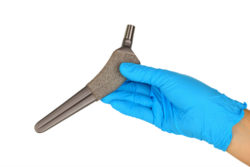 The FDA has begun an extensive investigation into the materials used in medical implants such as DePuy hip prosthetics.
The FDA has begun an extensive investigation into the materials used in medical implants such as DePuy hip prosthetics.
The investigation, which was begun in March, is focusing on the scientific methods used to evaluate materials used in hip implants and other implantable medical devices. It is also addressing the question as to why some patients react badly to these materials, while others suffer no adverse effects.
In an official statement, former FDA Commissioner Scott Gottlieb said, “Enhancing our collective understanding of materials science could lead to identifying materials that may cause an exaggerated response in sensitive individuals and advance the development of safer materials.”
FDA Advised to Require Ingredient Labels for Metal Devices
Due to the high amount of reported reactions to metal implants, in November 2019 the Food and Drug Administration’s Immunology Devices Panel advised the FDA to require more detailed labeling on devices including metal-on-metal hip replacement systems.
According to patients who spoke to FDA regulators about the adverse reactions they suffered after receiving metal implants, it is very difficult to trace the materials used in these devices. If medical devices were required by the FDA to list the ingredients, chemicals, and metals included in these products, it may be easier to assess and treat allergic and immune responses.
According to the FDA’s Aron Yustein of the Office of Product Evaluation and Quality, if the FDA begins to require more detailed labels for metal devices, this expectation of transparency regarding ingredients and chemicals may also expand to other medical devices and products, leading to greater patient safety.
About the DePuy Hip Implants
The DePuy Pinnacle Acetabular Cup System was made of metal on metal (MoM) construction. The metal used was an alloy of cobalt, chromium and molybdenum (CoCrMo), and was commonly used for joint replacements. This material was chosen because it appeared to be more resistant to pitting and corrosion.
Like other MoM hip implants, this DePuy hip product was subject to “fretting,” meaning that microscopic pieces of metal were sheared off of the components and released into neighboring tissues. This could result in severe allergic reactions, such as metallosis.
Another DePuy hip implant, the ASR XL Acetabular Cup System, was subject to a Class 2 recall in August 2010. Today, there are no MoM joint implants on the market; however, many of these still remain inside of patients.
Symptoms of Metallosis
As metal debris builds up in the soft tissues, patients may experience pain around the implant site, pseudotumors (fluid build-up resembling a malignant tumor), and necrosis (literally, “tissue death”), exhibited by a serious rash. These symptoms result in the failure of devices such as DePuy hip implants, as the tissues that normally hold it in place become weakened or are destroyed altogether.
It should be noted that most otherwise healthy patients have not experienced adverse reactions. Patients who do tend to have pre-existing conditions or comorbidities, such as obesity.
Other Devices and Materials Being Investigated
Aside from materials used in DePuy hip implants and similar devices such as the Zimmer MMC Cup, the FDA investigation is looking at other types of metals and plastics that are being used in reconstructive and cosmetic surgery. For example, an alloy of nickel and titanium, known as nitinol, is commonly used in devices employed in laparoscopic surgeries because of its flexibility.
Another suspect material was the nickel alloy used in the Essure contraceptive device. Women who had this implanted experienced auto-immune reactions and hormonal disruption.
While many patients suffer no reactions at all to these materials, others experience severe symptoms even at low levels of exposure.
Reactions and Symptoms May Develop Later
Although MoM DePuy Hip implants are no longer sold, they were employed in thousands of hip arthroplasty procedures. Thus, thousands of people continue to have this device inside of them. Some of these patients who have had no problems with them in the past may develop symptoms years after the original surgery.
These delayed adverse reactions may be due to the time it takes these metal devices to wear down and release metal ions into the bloodstream. Over time, these devices may also shift out of place, leading to instability and injuries.
Metal parts may also grind against the patient’s bones, leading to injuries, decreased range of motion, and pain. While these devices may not result in immediate side effects for patients, the damage caused by metal-on-metal devices may build up over time, leading to future adverse reactions.
It’s Been Tried Before
In a recent lawsuit filed in Illinois, the plaintiff’s attorney presents some shocking evidence: it turns out that MoM devices such as the Zimmer and DePuy Hip Implants have been introduced before – decades ago, in fact. Allegedly, they had the same problems as they do today.
According to the complaint, orthopedic prosthesis designers started experimenting with MoM implants in the late 1960s. Their logic: metal was stronger and offered greater durability than the plastics available at the time. They also believed that the added strength of the metal would enable them to design prosthetic devices that would offer a greater range of motion.
The experiment lasted only a few years. By the mid-1970s, it was found that patients who had gotten the new MoM devices were suffering from “heavy [metal] poisoning and adverse local tissue reactions caused by metal ions released from the MoM bearing surface.”
In other words, the plaintiff argues, these hip implants caused the same exact problems that patients are experiencing today, nearly a half-century later! Because of this, the industry of that time quickly abandoned the use of MoM construction and started using polyethylene plastic, which became the industry standard.
Unfortunately, because the use of MoM components was so limited and the technology had been abandoned in such a short time, there were virtually no clinical studies performed that would have shed light on just how these devices harmed patients. This left the door open for latter-day manufacturers to attempt more experiments with technology they should have known had failed previously, the plaintiff claims.
This Metal-on-Metal Hip Replacement Lawsuit is Case No. 3:19-cv-50124 in the United States District Court for the Northern District of Illinois, Rockford Division.
ATTORNEY ADVERTISING
Top Class Actions is a Proud Member of the American Bar Association
LEGAL INFORMATION IS NOT LEGAL ADVICE
Top Class Actions Legal Statement
©2008 – 2026 Top Class Actions® LLC
Various Trademarks held by their respective owners
This website is not intended for viewing or usage by European Union citizens.
E-mail any problems with this form to:
[email protected].
Oops! We could not locate your form.












